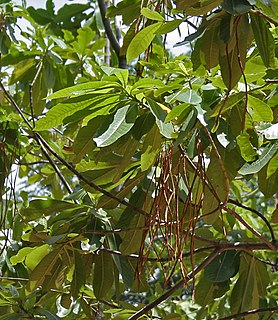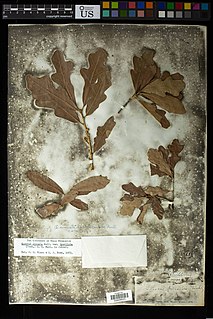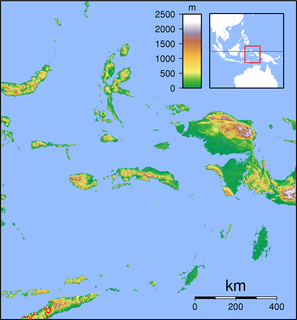
Meru Betiri National Park is a national park in the province of East Java, Indonesia, extending over an area of 580 km2 of which a small part is marine (8.45 km2). The beaches of the park provide nesting grounds for endangered turtle species such as leatherback turtles, hawksbill turtles, green turtles, and olive ridley turtles.

Alstonia is a widespread genus of evergreen trees and shrubs, of the family Apocynaceae. It was named by Robert Brown in 1811, after Charles Alston (1685–1760), professor of botany at Edinburgh from 1716 to 1760.

West Bali National Park is a national park located in Buleleng Regency, Bali, Indonesia. The park covers around 190 square kilometres (73 sq mi), of which are 158 square kilometres (61 sq mi) land and the remainder is sea. This is approximately 3% of Bali's total land area. To the north, it includes a 1,000-metre (3,300 ft) long beach, reef and islets. A seaport at Gilimanuk is west of the park, and the village of Goris is to the east. The National Park can be reached by roads from Gilimanuk and Singaraja, or by using ferries from Ketapang, East Java.

The Trobriand Islands rain forests are a tropical moist broadleaf forest ecoregion of southeastern Papua New Guinea.

Alstonia scholaris, commonly called blackboard tree or devil's tree in English, is an evergreen tropical tree in the family Apocynaceae. It is native to southern China, tropical Asia and Australasia, it is a commonly planted ornamental plant in these areas. It is a toxic plant, but traditionally it is used medicinally for myriad diseases and complaints.
Alstonia angustifolia is a species of plant in the family Apocynaceae. It is found in Indonesia, Malaysia, the Philippines, and Vietnam. It can be used to relieve headache.
Alstonia annamensis is a species of plant in the family Apocynaceae. It is endemic to Vietnam.
Alstonia beatricis is a species of plant in the family Apocynaceae. It is endemic to West Papua (Indonesia).
Alstonia henryi is a species of plant in the family Apocynaceae. It is endemic to China.

Alstonia macrophylla, the hard alstonia, hard milkwood or big-leaved macrophyllum, is a species of plant in the family Apocynaceae.
Alstonia marquisensis is a species of plant in the family Apocynaceae. It is endemic to French Polynesia.
Alstonia penangiana is a species of plant in the family Apocynaceae. It is a tree endemic to Peninsular Malaysia.
Alstonia pneumatophora is a species of plant in the family Apocynaceae. It is found in Indonesia, Malaysia, and Thailand.
Alstonia rubiginosa is a species of plant in the family Apocynaceae. It is endemic to Papua New Guinea.
Alstonia rupestris is a species of plant in the family Apocynaceae. It is endemic to Thailand.
Alstonia spatulata, also called hard milkwood or Siamese balsa, is a species of tree in the family Apocynaceae. It is found in Cambodia, Indonesia, Laos, Malaysia, Papua New Guinea, the Philippines, Singapore, Thailand, and Vietnam.

Quercus sinuatavar. breviloba, commonly called Bigelow oak or Bigelow's oak, is a variety of Quercus sinuata, a species of oak tree that grows in parts of the southern United States and northeastern Mexico. Common names for this taxon are shallow-lobed oak, white shin oak, scaly-bark oak, limestone Durand oak, and shortlobe oak. The less specific common name bastard oak may refer to either of the two varieties of Quercus sinuata, var. sinuata and var. breviloba. Other common names include scrub oak or shin oak, but these names may refer to a number of other low growing, clump forming oak species, subspecies or varieties. For clear differentiation in common reference, American Forests uses Durand Oak to mean Quercus sinuata var. sinuata and Bigelow oak to mean Quercus sinuata var. breviloba, a shrubby variety of Quercus sinuata distinguished in part by its habit of forming clonal colonies in parts of its range.

Manusela National Park is located on Seram island, in the Maluku archipelago of Indonesia. It is made up of coastal forest, swamp forest, lowland and montane rainforest ecosystem types. Mount Binaiya at 3,027 meters, is the highest of the park's six mountains. Seram is remarkable for its high degree of localised bird endemism. The park also includes important karst landscapes. On Mount Hatu Saka, near the coast of Saleman-Sawai, it is the Goa Hatusaka, currently the deepest cave of the whole Indonesia.
Alstonia boonei is a very large, deciduous, tropical-forest tree belonging to the family Apocynaceae. It is native to tropical West Africa, with a range extending into Ethiopia and Tanzania. Its common name in the English timber trade is cheese wood, pattern wood or stool wood while its common name in the French timber trade is emien.

Quercus sinuata is a North American species of oak comprising two distinct varieties, Quercus sinuata var. sinuata and Quercus sinuata var. breviloba. Morphologically intermediate forms may occur where range overlap brings the two taxa together. Quercus sinuata var. breviloba is native to central and north central Texas, south central and southwest Oklahoma, and to Coahuila, Nuevo León, and Tamaulipas in northern Mexico. Quercus sinuata var. sinuata is native to the south-central and southeastern United States from central Texas and southwestern Arkansas to the Carolinas. Their respective ranges intersect in the Hill Country of central Texas, where streams flowing through dry, brushy limestone hills create a mosaic of wet and well drained habitats.









